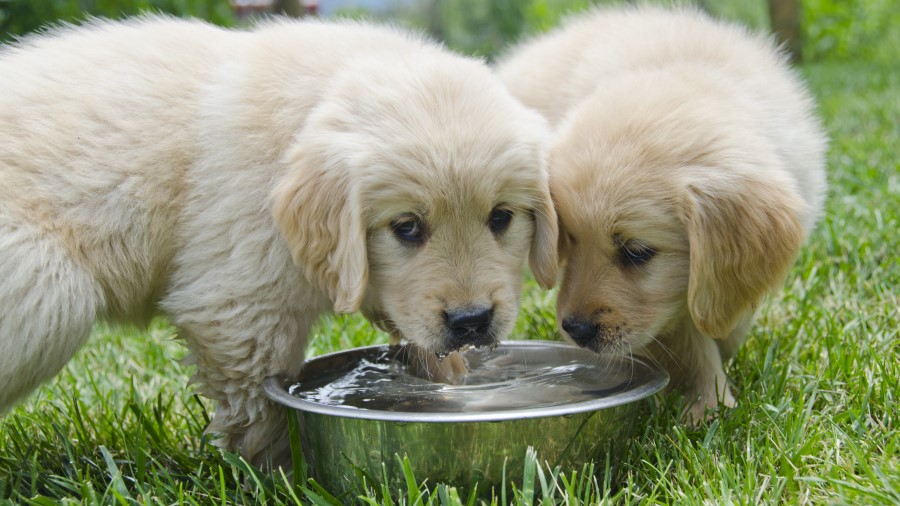Watching a pair of dogs run and tumble energetically together around a park is certainly amusing and enjoyable for the human owners, but what is happening for the dogs involved? Research shows us that social play serves a range of possible functions for dogs during their cognitive and social development, can be a useful form of exercise, and seems to help reduce stress for some individuals. There’s no doubt that social play is a voluntary activity sought out by many dogs, but many others appear to find the subtle signals of social play difficult and stressful to interpret.
We can only speculate about the complex emotions involved in play interactions between two or more dogs, but we can observe body language signals displayed during social play to help us determine when the participants are likely having a good time, and when they are likely not. Providing positive interactions when socialising your dog as a puppy and identifying their play preferences as an adult will make social play a beneficial and enjoyable activity for your dog.
When Is Social Dog Play Okay?
We could assign many human ideas and emotions to dog play, but when it comes to assessing what is ok for the dogs involved, it is best to let the dogs’ actions do the talking. Body positions, patterns of movement, vocalisations, and the smaller, constantly changing signals displayed across a dog’s face, body and tail, provide a picture to help us decide if the play is safe, appropriate, and beneficial for all parties involved at any one moment.
Despite the animated and sometimes rough appearance of play between dogs, social play is somewhat mediated by the social rules of fairness and reciprocity. An ideal play scenario would see each dog take a turn at ‘winning’ and ‘losing’ the game; you chase me, I chase you; you tumble me, I tumble you. This kind of reciprocal interaction keeps the players fair.
What Is Appropriate Dog Social Play?
To meet the criteria for appropriate social play, the participating dogs would need to do the following:
- Facilitate reciprocal play by taking turns to ‘win’ and ‘lose’
- Self-handicap: adjust the intensity of play to accommodate a smaller, weaker, less experienced, or younger dog
- Regularly announce their intentions: use body postures like the play bow to assure the other dog that this interaction is play, not a threat
- Maintain low arousal (not get too excited!)
- Take breaks/pauses between action
- Read and respond to their play partner’s body language, adjusting or stopping play accordingly
This sounds complex because it is! As a human, it can be difficult to identify the codes of social play as they happen. Observing your own dog’s body language, and that of any play partners, will tell you how comfortable your dog is and how well they are adapting to the play.
Signs of relaxed, comfortable play include:
- Loose muscles, a wiggly or bendy body
- Exaggerated movements like bouncing, moving between a down and stand, turning/spinning
- Voluntary vulnerability; rolling over, allowing themselves to be caught/tumbled
- Brief contact like hip bumps, single paws, neck/face mouthing
- Invitational postures like play bows
- Loose, open mouth
- Vocalisations: continuous growling with open mouth, chatter, attention seeking barks
- Pauses between movements and short breaks between chasing/wrestling
What Are The Signs of ‘Inappropriate’ Dog Social Play?
Signs of discomfort, arousal, or escalating aggression in play include:
- Tense muscles with stiff movement, or no movement/momentary freeze
- Maintaining frontal position, weight over toes, chest forward
- Sustained contact; chin over, paw/leg over, mounting, continuous body-slamming
- Avoidance; hiding, continuously moving away, seeking out owner
- Displacement behaviours like scratching, eliminating, sniffing, while ignoring other dog
- Closed, tight mouth, may see lips lifted or teeth bared
- Vocalisations: low growling with closed mouth, short, high-pitched barks strung together
- Relentlessly following other dog, no breaks in action

How Can I Safely Interrupt Social Play Between Dogs?
Interrupting play should never be harsh or frightening to any dog involved; the dogs are not in trouble and they should not be scolded or physically dragged away from the other dog/s.
Call your dog’s name and ask them to come (recall) to you. Always offer reinforcement for recalling to you. Feeding the dog while you reach for their collar and attach a lead will help keep them distracted from the other dog.
Lure your dog away. Call your dog’s name or make calm clicking/kissing sounds as you approach. If the dogs are mouthing one another with face-to-face contact, you will need to distract them momentarily, so they separate their heads. Use a handful of treats placed in front of their nose to lure them away from the other dog, reaching to hold their collar and attach a lead as you move and feed. You should ideally have the other dog’s owner lure their dog away at the same time so both dogs are distracted by separate handfuls of treats.
Body block. If your dog does not respond to their name and is unable to follow a lure, you may need to move between the two dogs as a visual block. This should provide a momentary break in your dog’s focus on their playmate and allow for you to lure them away, as above. It is important to only step between dogs and body block if it is safe to do so. Asking the other dog’s owner to block their dog while you block yours will help.
Once you have separated your dog from the play and attached their lead, walk them a short distance away from their playmate, keeping their focus on you (tip: use treats!) Try asking for a few basic cues (sit, down, stand, shake) to help them refocus on you and calm down. Return them to the play if they have remained calm and focused on you; they should be showing relaxed body language with no stress signs. If they remain very stressed or over-aroused it may be best to end the play session. Hopefully, your dog will only need a brief pause in play to calm down enough to return to their friend.
Why Can’t I Just Let Dogs Sort It Out Themselves?
While most dogs ‘speak dog’ better than any human can, no dog has a perfect set of social skills. Even the most polite and well-socialised dog can accidentally violate the rules of fair play. Modern day dogs spend most of their time outside of the home on lead, or off-lead in a designated enclosed space like a dog park. Because of these necessary measures of containment, dogs have fewer options when meeting unfamiliar dogs, and are often (albeit unintentionally) forced to engage where they would choose otherwise. Despite owners’ best efforts during critical socialisation periods, it remains difficult to provide the ideal environment and experiences to equip dogs to deal with all possible social encounters. Human management of greetings and play interactions is therefore necessary to prevent negative, and potentially harmful, experiences.

Preparing Your Dog For Social Play
There are many things you can do to prepare your dog for social interactions with other dogs, whether they be brief encounters or enthusiastic play sessions. Creating safe and controlled opportunities for your puppy to see and meet other dogs during their critical development periods will have a greatly positive influence on their social skills in later life. Teaching your puppy to be calm and comfortable in the presence of other dogs makes them much more likely to approach play encounters politely and confidently. Even if they have never engaged in extended play, your puppy has learned how to read other dogs, and how to focus on you in the presence of other dogs, both very important skills!
It is never too late to learn your dog’s body language and identify what they might be feeling. Owners of puppies and adult dogs alike should prioritise understanding the basics of dog body language in order to recognise signs of stress and know when to jump to their dog’s aid. Teaching foundation cues like ‘Look’ and ‘Come’ (recall) is equally important; these cues help to redirect or remove your dog from undesirable situations.
Training basic cues also strengthens the bond between you and your dog; they know that you always clearly communicate what you want, and that there are often yummy treats involved when you practice cues together. In stressful situations, the positive associations your dog has with you help to reinforce your status as a safe and reliable source of comfort. They know you can get them out of trouble and will seek you out if they are feeling uncomfortable or overwhelmed during a social interaction.
Managing Your Dog’s Social Play
When your dog is ready to engage in play you should be prepared to observe and interrupt the play session if necessary. It isn’t safe or responsible to leave your dog unsupervised during play, especially off-lead in a public dog park or with dogs that are unfamiliar to you and your dog. Even if your dog is a social butterfly and generally appears relaxed and respectful in play, you should be on hand to mediate should anything go wrong. Remember, dogs have complex emotional lives and respond to subtle changes in the environment, so they are never totally predictable!
One of the easiest ways to avoid a negative play experience for your dog is to first consider what kinds of dogs would make the best playmates. This will vary depending on your dog’s social experience, play style, and preferences, as well as their age and health status. Of course, some matches would very evidently be a disaster; you wouldn’t allow your six-month-old Great Dane puppy to play with the neighbour’s 16-year old Chihuahua because this would likely pose a significant safety risk to the smaller, older dog. Other potentially inappropriate pairings are less obvious.
The key objective when managing play between dogs is to maintain the safety of all dogs involved. Management also serves to prevent negative experiences that could influence a dog’s behaviour in future, and to teach dogs how to adapt during play and to uphold the social rules of fairness and reciprocity.
If you want to learn more then come to any of our Puppy or Dog training classes at our clinics. You can always speak to your local Greencross Vets for more advice.

 Greencross Vets
Greencross Vets 











